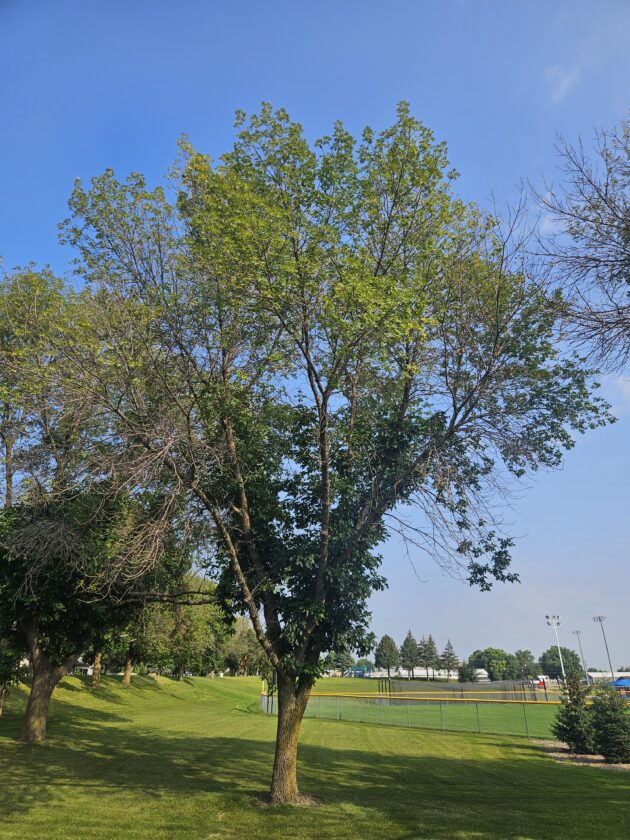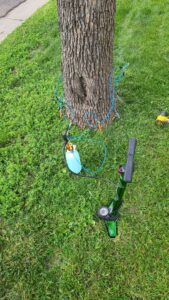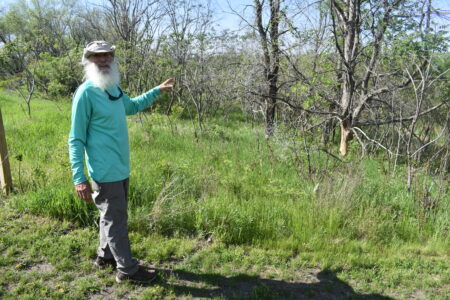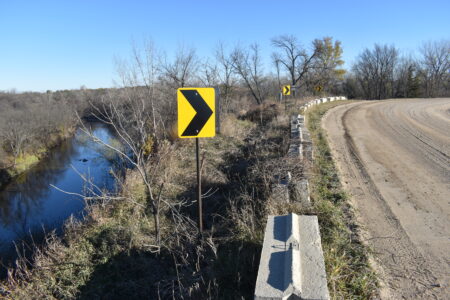‘At our peak’ in removing ash trees
Emerald ash borer affecting nearly all of New Ulm’s ash trees
- Photo Submitted by John Sanford: This tree is showing drastic affects of Emerald Ash Borer, with no hope of treatment.
- Photo Submitted by John Sanford: Belek’s Tree Service sets up a treatment solution for this ash tree. Treatments need to be done every two years.
- Joe Gertner points out a severely affected Emerald Ash Borer tree at Pollinator Park.

Photo Submitted by John Sanford: This tree is showing drastic affects of Emerald Ash Borer, with no hope of treatment.
NEW ULM – With hundreds of trees in the throes of emerald ash borer (EAB), efforts are continuing to tend to this problem.
Belek Tree Service, owned by John Sanford, is one of the businesses invested in taking down ash trees. He said EAB has been good for his business in the short term, but will eventually take its toll.
“Short term gives us a lot of instant work,” he said. “People need these ash trees cut down now. We’re afraid in the long term it’s gonna hurt us. In the sense 30% of New Ulm’s trees are ash. Once they’re all dead, they’re gone. We’re gonna lose 30% of our potential trimming business.”
Sanford said his tree service works on ash trees nearly every day. He said the further along ash trees are in EAB infestation, the harder it is to take them down.
“Once ash trees are killed by EAB, they become very brittle,” Sanford said. “Branches break out of them very easily. The longer they’re dead the more that is. If we can’t get equipment to these trees, we have to climb. It drastically affects how we take them down and how much longer it takes.”

Photo Submitted by John Sanford: Belek’s Tree Service sets up a treatment solution for this ash tree. Treatments need to be done every two years.
If trees are less than 20% affected by EAB, Sanford said he usually defers to treating the ash tree. He said treatments are administered every two years. If it is between 20-50% dead, he discusses with the homeowners the best course of action. Any more than 50% affected, and they need to be removed.
“It’s not a disease,” Sanford said. “The insect eats the tree alive. All we have to do is kill the insects and everything that’s there is going to stay there.”
Replanting is also not a popular decision. Sanford said around 25% of people who have ash trees taken down replant something in its place.
“They’re just tired of the tree,” he said. “They say ‘I bought this ash tree, it cost me to plant it. I put all this money into growing it, and now it died.”
Tuesday’s City Council Work Session featured a discussion on EAB. City Manager Chris Dalton said they have heard complaints from several people about how the trees look and the dangers they pose. He said Broadway is owned by MnDOT, and they have a plan to take down trees this year in the center median. If they can, they would then work on the boulevards.

Joe Gertner points out a severely affected Emerald Ash Borer tree at Pollinator Park.
Councilor Les Schultz asked if MnDOT would be using local crews. City Engineer Joseph Stadheim said they would likely contract internally, with crews from the metro area.
Dalton said they would also not replant trees. To help support locals with removing ash trees, he recommended allocating $100,000 in the budget toward a program reimbursing some of the removal costs.
“A citizen [says] ‘I want to remove my tree, here’s my bid.'” Dalton said. “We would reimburse up to 50% or $600, whatever comes first. It would be on them to take those trees down.”
There is currently a reimbursement program, but it ran out of money in July. Engineering Tech Jeff Anderson said $12,800 was put into the program this year.
The city will continue to apply for grant funding as well, but after receiving two initial grants Dalton said it would be unlikely they receive a third.
Park and Rec Director Joey Schugel said it has gotten very competitive statewide for assistance with EAB.
“There was $6.5 million available for funding this year from the state,” he said. “There was $36 million of applicants requesting. They obviously couldn’t fund everyone.”
Schugel said Park and Rec has removed 60 trees internally in the last three years. He said usually their line item for tree replacement is $5,000, but this year they’re starting with a $30,000 request. Stadheim said there are around 2,000 ash trees left on private land and 638 on boulevards.
Councilor Dave Christian asked if the city would make people put trees back in. Stadheim said that is encouraged but not a requirement.
“Reforestation is going to be another issue [down the road],” Stadheim said.
While it is not ideal now, Stadheim said it’s likely not going to get worse.
“We’re most likely at our peak or very close to it,” he said. “We’re fully infested. As trees continue to come down, hopefully we’re on the down slope of that bell curve. It’ll take probably three to six, years to get a good handle on removals that need to happen.”






